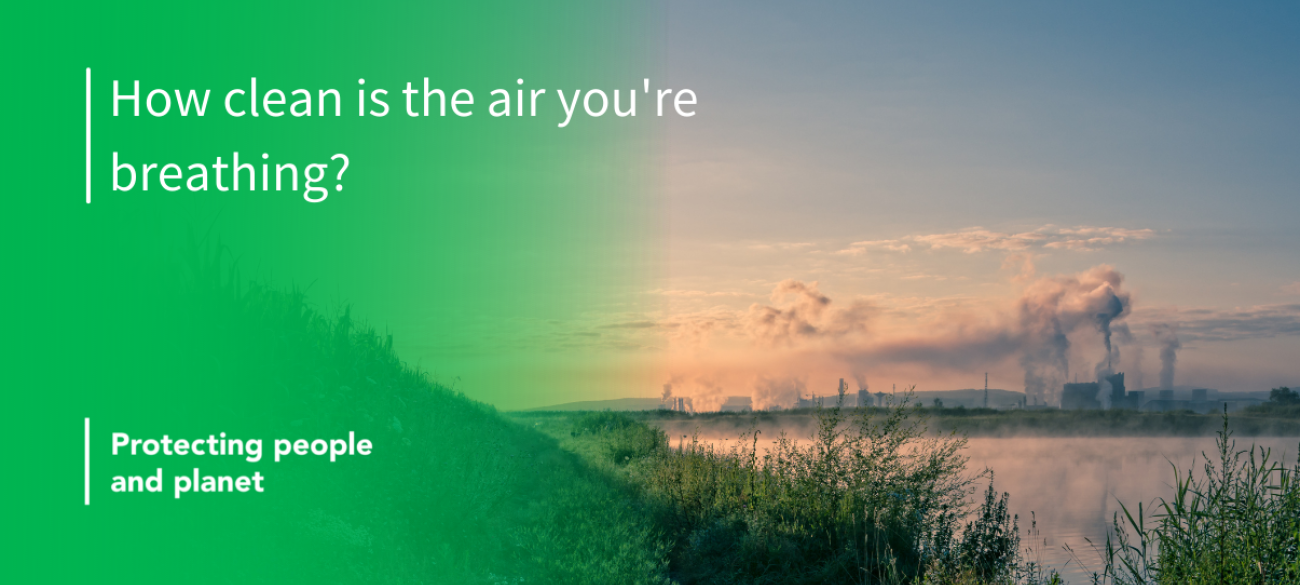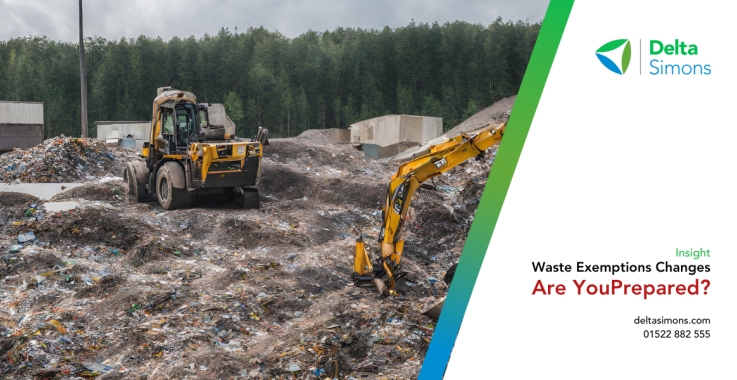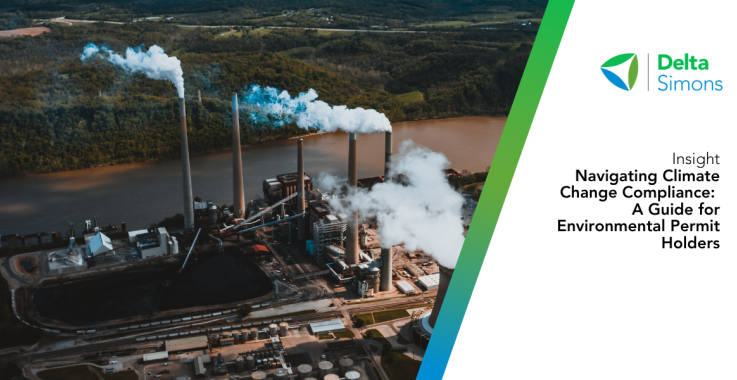Air Quality: How Clean Is The Air You Are Breathing?
30 Mar 2022
Environmental Planning
Air quality
According to strategic insight agency, Opinium, in 2018 the average Briton spent around 90% of their time indoors, a staggering 22 hours per day. Despite this, Indoor Air Quality legislation relating to office buildings and other such places of work continues to be vague and is often overlooked.
Delta-Simons’ Senior Air Quality Consultant, Siobhan Goodman, provides an in-depth insight into the detriment of poor air quality, what to consider when acquiring property and reveals why air quality should be at the top of your Environmental, Social and Governance (ESG) strategy.
A Healthy Workplace Environment: What Does This Mean?
90% of our time is spent indoors, yet many people do not consider the health impacts of increased levels of CO2 in the room, or the presence of Volatile Organic Compounds (VOCs), a bi-product of off-gassing from things such as newly bought furniture, paint, perfumes, as well as outdoor pollutants entering the building from sources such as transport, energy supply, dust, agriculture, waste management or other air pollutants.
The effects of poor air quality on the human body, both physically and mentally cannot be ignored. Eye irritation, headaches, dizziness, fatigue and inability to concentrate are some of the few subclinical Sickness Building Syndrome (SBS) symptoms that often get attributed to other possible causes. Chronic long term exposure to air pollution, both indoors and outdoors, can lead to more serious diseases such as cardiovascular disease, strokes and a variety of cancers as well as some studies presenting evidence of links to Alzheimer’s and other neurodegenerative diseases.
“Indoor exposure to air pollutants causes very significant damage to health globally[.] Despite this, public health awareness on indoor air pollution has lagged behind that on outdoor air pollution.” - WHO Guidelines for Indoor Air Quality,2010
Many people breathe air that fails to achieve the WHO guidelines with air pollution killing more than an estimated 7 million people per year, world-wide, prematurely, of which 3.7 million are attributed to poor indoor air quality. The majority of humans can agree we all have a right to access clean water, but why does this not extend to our right to breathe clean air.
But the effects of poor air quality aren’t limited to human health. According to the 2004 study ‘The effects of indoor air quality on performance and productivity’, the effects of poor indoor air quality have a direct impact on performance and productivity. The study states that the data collected from a series of experiments where participants in office buildings were exposed to a variety of air quality levels, that “[t]he size of the effect on most aspects of office work performance appears to be as high as 6-9%[.]”
Negating acknowledgement of the dangers of air pollution and poor air quality (indoor or outdoor) and negating taking action to mitigate the risks is both a short and long term risk we can’t afford.
Occupational Health and Exposure: What’s Safe?
So we know that poor air quality and air pollution is bad for our health and bad for business. But what does ‘bad’ actually mean? The air we breathe contains a mixture of liquids and gases containing a variety of chemicals (known as Particulate Matter or PM for short) some of which, in higher concentrations, can have an adverse effect on our bodies. The most damaging of these particles are known as PM2.5. PM2.5 particles are invisible to the naked eye, 30 times smaller than a strand of human hair, and can be inhaled into our lungs, passed into our bloodstream and, subsequently, enter our organs.
The current legal limit of PM2.5 in the UK is set at nearly twice the level the WHO recommends (5 µg/m 3 per annum). The Air Quality Standards Regulations 2010 states that concentrations of air pollution PM2.5 must not exceed an annual average of 25 µg/m3. Whilst the latest figures provided by the government demonstrate a marked decrease in exposure to PM2.5 toxins, exposure is still relatively high when we consider the recommended levels of exposure presented by the WHO. The WHO states that exposure to PM2.5 is estimated to be on par with other major global health risks such as unhealthy diets and tobacco smoking. Despite air pollution being coined as the new second-hand smoke, UK regulations relating to indoor air quality continues to be vague.
The HSE’s INDG244 Workplace (Health, Safety and Welfare) Regulations and the related Approved Code of Practice (ACoP), surmises that indoor air quality should be at least equal to, but ideally better than, the air quality outside your building. Regulation 6 of the Workplace (Health, Safety and Welfare) Regulations 1992 states: “Effective and suitable provision shall be made to ensure that every enclosed workplace is ventilated by a sufficient quantity of fresh or purified air." The ACOP also states that “The air which is introduced should, as far as possible, be free of any impurity which is likely to be offensive or cause ill health".
Many harmful substances are covered by the COSHH 2002 regulations, Workplace Exposure Limits (WELs), requiring employers to control substances in workplaces that are hazardous to health. COSHH regulations state that measures need to be taken to ensure the internal environment maintains good air quality and reduces the presence of common indoor air pollutants such as CO2, NO2, and VOCs. However, like the recommended levels of PM2.5, being below recommended exposure limits does not make exposure to these substances safe.
Furthermore, according to the Institute of Air Quality (IAQM) guidance, places of work, such as offices, are not classified as sensitive receptors. Currently, there is no direct requirement for employers to consider conducting an Indoor Air Quality Assessment, let alone put measures in place to improve current air quality levels. However, every year we, Delta-Simons, are seeing more and more companies incorporate sustainable measures to reduce their impact on air quality. In light of how vague the current guidance is and the levels of exposure not truly combating the issue, one has to ask the question, why?
It could be to mitigate any legal issues relating to the HSE guidance and further, the Health & Safety at Work Act 1974 and the Occupiers Liability Act 1984; “an employer has a duty of care to ensure that a safe and healthy environment is provided”. It could be to improve productivity output and reduce worker sick days. However, I believe the motivations behind companies looking to improve their indoor air quality runs deeper.
Air Quality: The Bigger Picture
Aside from the effects of poor air quality on the human body and productive output, air pollution is one of the biggest driving forces behind climate change. Cited by the United States Environmental Protection Agency, there is a cyclical effect of air pollution and poor air quality impacting climate change, which in turn worsens the air quality further affecting the climate. Climate change influences air pollution by altering the frequency, severity, and duration of heatwaves, air stagnation events, and other meteorology conducive to the accumulation of heatwaves. Climate change can also impact local and regional meteorology which can alter the source, transfer and loss of air pollutants.
As our ‘Always On’ lifestyle continues to develop, it’s important for companies of all sizes to demonstrate themselves as leaders in tackling climate change through action, big or small.
First widely acknowledged when the United Nations published their landmark report, ‘Who cares wins’ in June 2004, Environmental Social Governance (ESG) is a set of standards for a company’s operations that socially conscious investors use to screen potential investments. The introduction of ESG in the 2004 report emphasised the need to make ESG principles and actions fundamental to making financial investments. This report was released at a time when global public visibility of environmental crises was fast increasing, promoting an understanding amongst many business leaders and financial institutions that the minimal legal requirement was no longer good enough. Companies needed to start considering the impacts of their operations on their employees and the wider environment.
Whilst the adoption of ESG principles has been slow, as global environmental and business sustainability issues become more prevalent such as; environmental pollution, flood risks, climate change, privacy and data security, demographic shifts, and regulatory pressures, the increased risk factors for investors and employers have forced businesses to change.
Investing For The Future: Mitigating The Risk of Poor Air Quality During Acquisition and Maintenance of Properties
Acquiring and maintaining property carries risk at all stages of the property life cycle. Whether you are looking to acquire or maintain an occupied building, I recommend thoroughly assessing the baseline conditions of both the external and internal environment of your building asset as part of your Environmental Due Diligence process.
One key consideration to take during due diligence is identifying Air Quality Management Areas (AQMA), areas where air pollution is above the legal limit, and where other air pollutant factors, including reviewing background concentrations, that may contribute to poor air quality within your building should be considered.
It is important to note that environmental due diligence takes time. As an established multi-disciplinary environmental and health and safety consultancy, and trusted providers of Air Quality Consultancy, we recommend, as part of your wider Building Research Establishment Environmental Assessment Method (BREEAM), we recommend determination periods of;
10 Day Determination Period:
The 10 day determination period allows for a top-level screening assessment of potential risks to air quality at the site and the surrounding areas followed by a proposal for ongoing monitoring.
100 Day Determination Period:
100 days after the initial assessment a prepared Compilation and Accounting report which considers baseline conditions at your site and an evaluation of whether there are any specific air quality policies and guidance documents relevant to your asset or the surrounding environment. From this, an Indoor Air Quality (IAQ) Action Plan, which looks to control, reduce, and remove occupational exposure to toxic substances, can be proposed and implemented.
The determination period is essential to ensure you make the correct investment choices and that your subsequent actions are the correct actions for making a positive impact on air quality. Negating spending time on your due diligence process can leave you out of pocket and your team less productive.
Operating Healthy Buildings Is Future-Proofing Your Business
Public engagement in air pollution and the subsequent health impacts of poor indoor, and outdoor, air quality, has historically been low. The COVID 19 pandemic has brought the issues of poor air quality to light. The notion that, as human beings, we all have a right to a clean environment, so we should all have a right to clean air, is fast becoming the norm.
Ensuring you are operating healthy buildings will save you time, money and reputation in the long run. Engaging with a nationally trusted provider of Air Quality services will help you to support the physical health of your building occupants, reduce the risk of health concerns associated with indoor air pollution, and uphold or improve productivity, whilst setting you on the right path to achieving your ESG goals.
Our Capabilities
As part of the Lucion Group, we deliver a full end to end service. From surveying, testing, and analysis of hazardous substances through to consultancy and delivering solutions.
Our knowledge of the issues surrounding the risk management and legal compliance of hazardous materials in buildings gives our commercial clients complete reassurance throughout their project, with real-time visibility of all hazardous materials and all risks. At the heart of everything we do is ESG (Environment, Social & Governance) and for Delta-Simons, success means a positive impact on people, the planet and prosperity.
Want to partner with a purpose-driven holistic environmental services supplier? Email us at air.quality@deltasimons.com.
About the Author
Siobhan Goodman BSc (Hons), MSc, AMIEnvSc
Senior Consultant - Air Quality
As a Senior Air Quality Consultant for Delta-Simons, Siobhan regularly prepares detailed road traffic and industrial emissions dispersion modelling assessments for a wide variety of projects across the UK including residential, commercial and industrial developments.
Siobhan has extensive experience in all aspects of Environmental Planning including undertaking diffusion tube surveys, desk-based odour assessments, and reviewing the effectiveness of the Clean Air Zone legislation and proposals. Additionally, Siobhan provides essential support to the day to day operation of the Air Quality and the wider Environmental Planning teams.
For further information about our Air Quality services, contact Siobhan:
Linkedin: Siobhan Goodman




